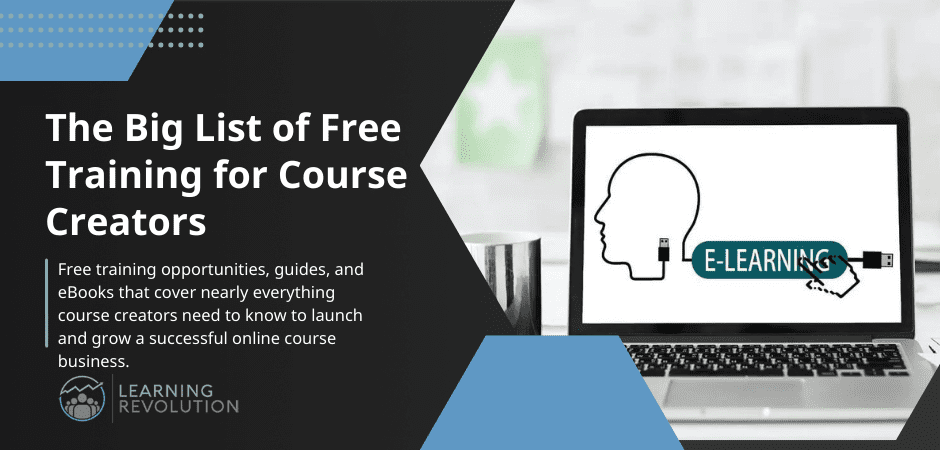

From consulting to writing to speaking, there have always been good ways for knowledgeable, experienced people to monetize their expertise. But in recent times, the possibility of being a course creator has become one of the hottest opportunities.
Or, at least, it has seemed that way for the past several years.
But is it still worth it to become a course creator, or has that ship of opportunity sailed?
In this article, we’ll take a look at course creation from multiple angles, consider just how much of an opportunity building courses still is in 2024, go over 9 steps to create an online course, and more.
Along the way, I’ll share a range of additional – and free – resources to help you on your journey as an edupreneur.
What is a course creator?
First things first: What do we mean by course creator?
Seems like the answer would be obvious, but as online course creation has grown in popularity, some confusion has grown along with it.
Historically, a “course creator” was simply a person who creates courses. But because software and the Internet have become such a big part of creating courses it can be easy to assume that course creation refers only to building online courses.
What’s more, the term may also now refer to the tools and platforms commonly used to build courses. So, you come across articles with titles like “The Best Online Course Creators” that are really focused on online course platforms or digital course authoring tools.
To be clear, my emphasis here will, in fact, be on building online courses, but I don’t want readers to lose site of the fact that online courses represent only part of the course creation opportunity. It is still perfectly possible – and much more so as we continue to emerge from the global pandemic – to deliver courses in person. In fact, with people hungry for face-to-face experiences, you can expect a strong resurgence in the seminar business in the coming 12-24 months.
Also, while I will talk about software tools and online course platforms some, my view is that – at least until artificial intelligence gets a lot more sophisticated – a course creator is a person, not a piece of software.
Specifically, a course creator is someone who structures valuable knowledge into a learning experience that enables learners to effectively access, interact with, absorb, and retain that knowledge.
The truth is, that definition holds true with or without software, online or off. Being a successful course creator is about delivering value in the form of a structured learning experience, value that produces a major positive impact for your learners.
Is it still worth creating an online course?
Still, like I said, I’m going to focus on building online courses here, mainly because it has been such a booming business opportunity for the past several years.
In fact, it’s been such a booming opportunity that it may be easy to think you have missed the chance to get in on it.
Bottom line: you haven’t.
The global e-learning market is projected to reach USD 390.6 billion by 2026, growing by 11.7% annually. (GMD Research). Within that overall market, the self-paced online learning market – one of the main areas of interest to aspiring course creators – is estimated to be worth over $15.86 billion in 2022 in the U.S. alone. (Source: Statista)
In addition to those numbers, consider that the online course marketplace Udemy currently claims more than 55 million learners – and it’s just one of dozens of large course sites that have been growing rapidly in recent years.
See a full rundown of e-learning statistics for course creators here >>
In other words, there is plenty of demand for online courses, and with the global pandemic having created a surge in e-learning that is unlikely to snap back to former levels, it’s a pretty good bet that online courses are a permanent part of the learning landscape in every field, industry, and part of human life – including whatever market you serve.
The obvious difference between now and 5-10 years ago is that there are a lot more course creators out there – and almost certainly some who will compete with you – but that just means you will need to do what any legitimate, successful business has always had to do: deliver a high-quality experience for your customers and do the work necessary to make sure your prospective customers know about your courses.
Of course, doing all of that requires actually building courses. So, let’s look at what that takes.
How do I create my own course? 9 key steps


Because of the great tools and platforms that are now available at relatively low cost (more on those shortly), figuring out how to create online courses has become relatively easy. It doesn’t take all that much, for example, to capture some video and string it together into lessons in an online course platform.
The problem is that this has gotten a little too easy to do. As a result, most course creators aren’t very strategic about the process and wind up with a course that doesn’t sell. Here are nine steps to overcome that problem and create successful online courses.
1. Start with value
When people ask me “How do you create an online course?” I sometimes give the glib answer “You don’t” – at least, not until you have a clear idea of what you aim to achieve with an online course, both for your learners and yourself.
If you just dive in and start creating, you’ll be lucky to hit the mark.
In the first place, while online courses are trendy, they aren’t always the right solution to address challenges or opportunities your potential customers may be facing.
Consulting, coaching, or even just a blog post or two – among many other options – may be a better way of delivering the needed value. If a course is overkill or just can’t get the job done well, then it’s unlikely to attract students.
And it’s easy to assume that just because we are qualified to teach a topic, and it seems valuable to us, prospective students will also perceive it as valuable. Always ask, “What positive, measurable change do aim to help my learners make in their lives, and where does an online course fit in helping to support that change?”
What positive, measurable change do aim to help my learners make in their lives, and where does an online course fit in helping to support that change?
2. Validate and refine
Being clear about the value you are aiming to create will lead you to ideas for your course topic as well as how you might want to position it (e.g., low-cost option for newbies, premium offering for more advanced students).
But don’t assume you’ve got it right. Before you start investing serious time and effort in course creation, you want to be as sure as you reasonably can that you have a topic that will really resonate with learners, attract prospects, and convert them into customers.
While there is no way to be 100% sure that you’ve come up with the right product, there are good ways to assess your market. To help with that, I’ve put together 15 ways to validate your course idea.
3. Take stock of your content
Many course creators start here and then dive into building their online course. Naturally, it’s important to know what content you have available for creating a course, but “taking stock” is critical. It means comparing your available content against what is truly needed to deliver the target outcomes for the course.
That means, of course, that you must be clear on what those outcomes are – and the work in the first two points should have gotten you most of the way there. What it’s important to remember at this point is that there is only so much you can achieve (or should try to achieve) with a single course. Most experts – and I’ve definitely been guilty of this myself – have a tendency to try to share everything they know about a topic, but that’s way more than the average learner needs or can absorb.
So, a big part of “taking stock” will be cutting content, getting rid of material that is not absolutely essential for achieving the target outcomes of your course. (I talk about cutting content more in section three of this article on recording virtual presentations.)
Of course, you will also inevitably discover gaps – e.g., places where you need to do some research, find new material, or otherwise fill out your content. Now’s the time to make a plan for doing that.
4. Make video your friend
This is by far the most tactical and technical out of my suggestions. Part of me hesitates to make it – arguably, your design and your methods are much more important than the media you use for delivering effective learning experiences. That said, there’s just no denying that digital video is pervasive these days and has become an expectation for online courses.
So, you’ll definitely benefit either from developing some video skills yourself and/or finding reliable help with shooting and editing video.
If you are shooting video yourself, it’s well worth investing in a basic home video studio. And keep in mind that you probably won’t just be shooting video of yourself – you’ll also most likely want the ability to record your screen and capture slides.
If you are looking for help with video, you can easily find contractors for just about any part of the process on services like Fiverr. Or, if you want in-depth support on video and all other parts of producing your course, consider our partner courseCREEK.
Also keep in mind that creating instructionally effective video requires more than just pointing a camera at yourself and pressing “Record.” You don’t have to become a pro at instructional design, but you should definitely spend some time learning about what instructionally effective videos involve. This post from The Learning Scientists is a great starting point.
5. Design the experience
We’ve already been hinting at the importance of design throughout this article. In theory, effective instructional design should have always been a top priority of course creators, but in my experience, it’s an area in which many – maybe most – online courses are sorely lacking.
You don’t have to be a business genius to figure out why that could be an issue if you want to compete effectively in today’s online course market. As noted very early on in this article, there are now a lot of online courses out there. At the same time, the general public has become much more familiar with online courses and most adults now have some experience with online learning. As a result, expectations have gone up.
The problem – at least for learners – is that so many online courses are essentially junk. They are dull, ineffective, and do not adequately support the target outcomes (to the extent that those outcomes are even well defined).
Of course, that problem is an opportunity for you. At least for the time being, one of the surest ways to stand out in the crowded online course market is to offer courses that are well designed, meaning they are instructionally effective and offer an experience that engages learners.
You don’t have to become an instructional or graphical design pro to capitalize on this opportunity, but it does pay to understand good design practices and either implement them to the best of your abilities or engage some professional help. Here’s some additional reading to help you with this one:
- How to Create an Online Course to Sell
- 7 Steps to Record a Successful Virtual Presentation
- Effective Strategies for Teaching Adult Learners
- 3 Conditions of Learner Engagement (Leading Learning)
6. Pilot and revise
This is one of the most important parts of the process. Really, I consider it part of #5 – Design the experience, but it is important enough to call out on its own.
In most cases, it doesn’t make sense to build a complete course and then put it out into the market. It’s better to build a rough, often partial version of the course and use that as a way to test your market and improve your overall design.
Here’s a basic 10-step course-piloting process I covered in an earlier post:
- Outline the basic curriculum for your course (or, possibly, a module from a larger course)
- Pull together your basic tools for promoting – e.g. – a series of 3-5 e-mails conveying the value of the course, a decent sales landing page to point people to
- Begin promoting to whatever audience you have. (You don’t have to have a huge audience at this point – just enough to get somewhere between 10 and 25 people into a pilot. Of course, you should always be working on building your audience.)
- Simultaneously, pull together any materials you may need for the pilot – e.g., slides, worksheets. Keep it very simple – go for “minimum effective dose.”
- For delivery, us a live platform like Zoom or Webinar Ninja. Yes, this will be a live pilot – that part is essential. You want to be able to interact with your students, change things on the fly, etc. And you don’t want the stress of committing your materials to a fixed, semi-permanent format.
- Run the pilot course over a period of days or weeks – whatever is appropriate for what you are teaching
- Collect feedback from students both during and after the pilot and use this to adjust along the way and for planning for your productized course.
- Collect testimonials from students – this will be invaluable in marketing your productized course.
- Assuming the majority of the feedback is enthusiastically favorable, and you can address any significant issues, proceed to creating the full course product. At this point, you may want to consider one of the many best online course platforms available for selling online courses.
- If the feedback is not what you were hoping for, or you encounter challenges that you need to work through, run a second pilot to test out changes. Repeat (within reason) until you have it nailed. Alternatively, you may discover that you just don’t have a sellable course idea and it’s time to try a different idea.
Yes, this may feel like extra work, but it’s one of the surest ways there is to avoid online course failure.
7. Create version one
Ironically, this is one of the shortest sections of the 9 steps because by this point you have done most of the heavy lifting. You’ve clearly identified the value you aim to deliver, validated your course idea, come up with a general design for the experience, and tested that approach with prospective learners.
Now you can invest the time and money necessary to put together a polished first version of the courses – and we’ll talk a bit more about the tools for doing that in just a minute. I’ll stress “first” version, because even at this point you will not really have a “final” product. You’ll continue to learn from your interactions with your customers and will no doubt want to release revised versions of the course in the future.
8. Launch with authority
If you have spent much time exploring the world of selling online courses, you may have noticed that there are two main schools of thought about how to bring your course to market.
One is focused on time-limited launches that the seller repeats over time – usually once or twice a year. The idea is to use the principle of “scarcity” to drive as many enrollments and as much revenue as you can during each limited launch period.
The other is built around keeping the course open perpetually, making it possible for new learners to enroll at any time and thereby – if successful – providing a continuous stream of revenue.
There are pros and cons to each approach, but really in either case you will want to support your course with a strong initial launch. After all, you will have put a lot of effort into it by this point, and you need to make sure the world knows about it.
Fortunately, just as with step #7 – Create version one, you’ve actually already done a lot of the heavy lifting if you have followed the other steps outlined here. As I’ve argued before, there really is no “secret” to an effective launch. Everything comes down to having identified a course that will resonate with your audience and doing everything you reasonably can to get in front of that audience with your offering.
9. Evolve and expand
Finally, don’t stop with the initial launch of your course. The truth is your greater opportunity as a course creator is probably over the long term as you get more data about what is actually resonating and working with your student. This data will provide insight into how to revise and improve your initial course over time and it will also point the way to ideas for additional courses and related offerings.
Always keep in mind that a course is just one possibility for sharing your knowledge and monetizing your expertise. So, keep an eye on your Value Ramp and don’t just assume that another course is always the best way to go.
The Digital Course Creator’s Toolbox


We’ll wrap up with some discussion of the types of tools you’ll need as a digital course creator and, in the next section, the type of platform you’ll need for delivery. I’ve already written a lot about both of these topics, so I’ll just provide some highlights here and then point you to other resources on the site.
Here are some of the major tools you will need to create and sell an online course.
Video Production Tools
As already noted, you are going to need to be able to produce videos if you want to create online courses of the type that people expect these days. It pays to invest in a basic studio set-up so that your videos will be as professional as possible.
Screen Recording Software
Software for screen recording or screencasting will enable you to make videos of anything on your computer screen – so for example, you can show your learners how to complete specific tasks. You can also film yourself and/or capture yourself narrating to PowerPoint slides. For my money, this is one of the most essential tools that any course creator can have. The one I most recommend is Camtasia.
Online Course Software
These are online course authoring tools that are usually much more feature rich than what you will find in the standard online course platform. They also empower you to create your courses according to major e-learning standards like SCORM. While you don’t have to use dedicated course authoring software, doing so will usually make it easier to move your courses from one platform to another and it also opens up more possibilities for selling online courses to businesses.
Images and Documents
Even if you don’t think of yourself as someone who can do graphic design or document layout, it pays to have some basic capabilities in these areas to support both the creation and the marketing of your online courses. Fortunately, there are now many different tools and services – from Canva to Fiverr – that help put professional looking images and documents within reach for every course creator.
Digital Marketing Tools
Last, but far from least, you are going to need tools that help you promote your online course. You may find most of what you need in your online course platform, depending on which one you choose, but in most cases, you are still going to want some additional tools to help with traffic generation, audience building, and conversion.
The links for each section above will take you to valuable tools in each area. One other key – and free – resource to make sure you grab is The Learning Revolutionary’s Toolbox. Just use the form below.
Which course platform is best?
Out of all the questions I get asked by Learning Revolution readers, some version of “Which course platform is best” vies with “How do I market my online course” for the number one spot.
Really the only correct answer to this question is “There is no best online course platform, there is only the best one for you.” And even that isn’t quite correct, because there are likely to be several that could work well for your needs. My main advice is simply to not obsess about your platform.
Yes, definitely take the time to choose thoughtfully using tools like my online course platform guide and worksheet, but don’t let choosing a platform grind your course creation efforts to a halt. The quality of your course and your audience matter much more than your platform.
That said, you do need a platform in most cases (though not all), so here are some resources to guide you in selecting one:
- The Key to Choosing an Online Learning Platform to Sell Courses
- 5 Online Course Platform Free Trials You Should Do
- The Best LMSes for Small Businesses
- The Best Platforms for Online Courses
And, again, be sure to get my free guide to platform selection.
The course creation opportunity is yours
So, with that we’ve moved from “What is a course creator” to how to create an online course to the tools and platforms you need to make it happen.
Now, the only missing ingredient is you.
I hope you will take everything discussed here and run with it. If you do decide to become a course creator, I encourage you to comment on this post and share what you learn from your journey. For support along the way, I also encourage you to subscribe to Learning Revolution updates to get helpful resources delivered straight to your inbox.
That’s all for now. See you at the Revolution!
Jeff
Table of Contents



